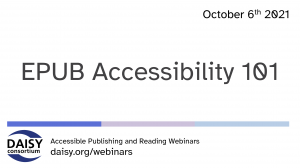EPUB Accessibility 101 (W)
 In our series of free weekly webinars October 6th saw a session focused on EPUB Accessibility. Our speakers showed everyone what happens under the hood of an EPUB file to support accessibility and managed to demystify some of the technicalities surrounding EPUB.
In our series of free weekly webinars October 6th saw a session focused on EPUB Accessibility. Our speakers showed everyone what happens under the hood of an EPUB file to support accessibility and managed to demystify some of the technicalities surrounding EPUB.
This page contains:
Full Video of the Webinar
Speakers
- Richard Orme, The DAISY Consortium—host and chair
- Rachel Comerford, Macmillan Learning
- Tzviya Siegman, J. Wiley and Sons
Session Overview
What is EPUB? The Basics
Rachel Comerford took us through some of the “acronym soup” that makes up an EPUB file, namely:
- Mimetype – which tells the reading system being used that this is an EPUB file
- META-INF – which points to the file and allows the reading system to find it
- OEPS-OPS – containing the content and everything needed to display that content (including the CSS which describes how the book should look)
What is EPUB? Focus on HTML
The text of an EPUB publication is written in HyperText Mark-Up Language (HTML) and Tzviya Siegman explained to us the importance for accessibility of the native semantic elements that can be conveyed within the HTML. Every element in the HTML mark-up contains a meaning and greatly assists with content navigation and order of reading layout.
What is EPUB? Focus on DPUB-ARIA and epub:type
Sometimes content is more complex than the available HTML elements can cope with and Accessible Rich Internet Applications (ARIA) provide another way of applying semantic meaning to content i.e. it describes a content component to the reader. DPUB-ARIA specifically maps to the epub:type vocabulary for EPUB content.
Navigating EPUBS
Rachel explained that all EPUB packages contain a navigation document (within the OPF file) from which the Table of Contents (TOC) is generated. The TOC is crucial for accessibility and together with headings, it generally echoes the familiar structure of printed content.
Links are also valuable for accessibility and it’s important to choose a reading system that exposes internal and external links to the reader.
The Value of EPUB Metadata
Also found in the OPF file, EPUB metadata provides information about the accessibility features and potential limitations of the content. Rachel urged us all to make as much use of metadata features as possible, not least via The Accessibility Summary section where the publisher can provide specific information for readers in a non-technical way. See the slide deck attached to this overview for a terrific example of this type of summary provided by Macmillan Learning.
Related Resources
- PowerPoint slide deck (1.2 MB)
- Full transcript Word document (38 KB)






